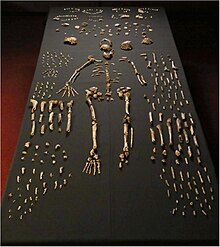Homo naledi
|
Homo naledi Temporal range: not dated |
|
|---|---|
 |
|
| A sample of the 1,550 skeletal pieces recovered | |
| Scientific classification | |
| Kingdom: | Animalia |
| Phylum: | Chordata |
| Class: | Mammalia |
| Order: | Primates |
| Suborder: | Haplorhini |
| Family: | Hominidae |
| Genus: | Homo |
| Species: | H. naledi |
| Binomial name | |
|
Homo naledi Berger et al., 2015 |
|
 |
|
| Location of discovery in Gauteng, South Africa | |
Homo naledi is an extinct species of hominin, which anthropologists first described in 2015 and have assigned to the genus Homo. In 2013, fossil skeletons were found in South Africa's Gauteng province, in the Rising Star Cave system, part of the Cradle of Humankind World Heritage Site. As of 10 September 2015[update], fossils of at least fifteen individuals, amounting to over 1550 specimens, have been excavated from the cave.
The species is characterized by a body mass and stature similar to small-bodied human populations, a smaller endocranial volume similar to Australopithecus, and a skull shape similar to early Homo species. The skeletal anatomy presents ancestral features known from australopithecines with more recent features associated with later hominins. The fossils have not been chronometrically dated, but estimates derived from statistical analysis of cranial traits have yielded a range of 2 million years (+/- 0.5 million years) to 912,000 years before present.
The fossils were discovered by recreational cavers Rick Hunter and Steven Tucker in 2013.Homo naledi was formally described in September 2015 by a 47-member international team of authors led by American-born South African paleoanthropologist Lee Berger of the University of the Witwatersrand, who proposed the bones represent a new Homo species. Other experts contend more analyses are needed to support this classification. There are some indications that the individuals may have been deliberately placed in the cave near the time of their death.
...
Wikipedia
